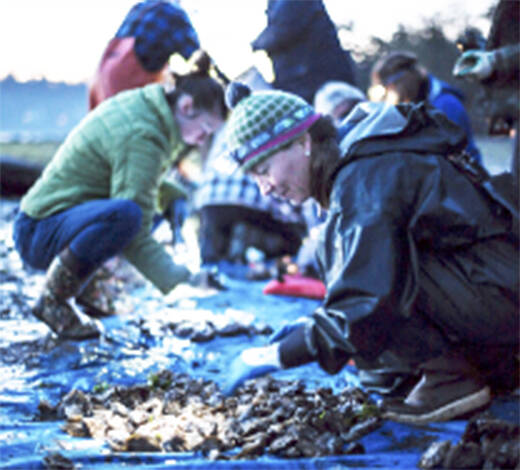The “world is your oyster” when it comes to community farming.
That means anyone can take the opportunity to oyster farm, thanks to the nonprofit Puget Sound Restoration.
And now, anyone also can have the opportunity to eat the home-grown shellfish, thanks to new Oyster Bar pop-ups at various places locally put on by Salish Sea Greens.
Josh Bouma of PSR said about 80 people a year buy memberships into the Port Madison Community Shellfish Farm on Bainbridge Island. They not only learn to grow Pacific oysters; they get to sort, harvest and eat them, too, as they get a regular allotment of the shellfish. “Part of the deal is participating in the process,” he said. “They are connected at a gut level.”
Bouma admitted there is a little bit of a risk involved because of pollution in Puget Sound. That can especially happen in summer when there can be a high mortality rate. “That’s yet another teaching tool,” he said.
Education is an important part of PSR’s mission. Not only do they teach folks how to farm, they also have schoolchildren learn about the important role oysters have in keeping Puget Sound waters clean. “We let them get their hands dirty,” he said.
‘Slurping oysters’
Bouma said he enjoys being on the beach with the students and farmers and, “slurping oysters with folks as we work.” He compared it to gardening. “It’s a similar process from start to finish.”
Bouma said many of the same people tend to buy memberships each year. The community-supported aquaculture program is “maxed out.” So, he’s hoping to maybe offer some month-by-month experiences in the future so more people can be a part of it. He’s also thinking of maybe having one big community event. “We might mix it up a little bit” in 2022, he said.
Olympic oysters, rather than Pacific, are native to this area. But they are very small. “Oly’s are tasty,” he said, adding the farm grows up to about 10,000 but it takes a long time for them to get up to harvest size.
Bouma said some people are worried about eating shellfish from Puget Sound because of pollution. But eating them actually helps clean up the sound, he said, adding one oyster can filter 20 gallons of seawater a day. “There’s a lot of nitrogen runoff in Puget Sound and a lot of algae. Oysters do an amazing job.”
Bouma said their farm is a “small footprint,” with an average of about 1,500 dozen oysters a year, approximately 1/10th of the size of the smallest commercial operation around.
While members get most of the oysters, some are sold to local restaurants, grocery stores or provided for fund-raising events.
Salish Sea Greens
But PSR is starting a new endeavor with Stephen Schreck. “I used to work for them” with kelp restoration, he said.
When he decided to do oyster bars as part of his Salish Sea Greens business, they joined forces.
“It’s another venue to service the oysters” as an outreach tool, Bouma said, adding he goes to them, too, and talks about the shellfish farm.
Schreck, who started his business about a year ago, said he takes the pop-up Oyster Bars to local wineries, so people can have a true “oyster experience.”
“Puget Sound is such a special place for seafood, especially shellfish,” he said. You get to “taste something especially fresh and truly local,” he said, adding he won’t serve anything over two days from harvest. Oysters are shucked and served on the half-shell. Lemon, hot sauce, or a “really popular” handmade vinaigrette dressing are available.
Like Bouma, Schreck said it’s important to educate the public that oysters are the most sustainable food source on the planet, and he wants to expand his opportunities for pop-up Oyster Bars in 2022.
Salish Sea Greens also promotes kelp, which Schreck calls a “superfood” with vitamins and minerals that promote brain function, fights disease, and provides antioxidants and energy. They make various types of kelp seasonings, such as smoked applewood, alderwood and curry – along with kelp sea salt.
Kelp also cleans up the Sound by absorbing carbon dioxide. It can grow 4 inches a day, 200 inches a season. “It’s one of the fastest-growing seaweeds in the world,” Schreck said. And it provides nourishment and a home for salmon, crab and rockfish, among others.
PSR efforts
As for PSR, it was founded in 1997 and its funds restore iconic species and habitats that are being diminished. Its goals are improving water quality, increasing native species and restoring habitat, along with other ecological benefits. It brings together funders, agencies, scientists, community groups and the public in an effort to re-create a healthy marine system that feeds and sustains everyone, its website says.
Bouma has been working there for about 10 years after working as a shellfish biologist and diver for the state Department of Fish and Wildlife. He likes the work. He said of their staff of 16, “A lot of folks here are motivated to preserve local marine resources. To restore important native species, water quality and habitat.”
He said PSR has cleaned up two other local areas with shellfish farms over the past 20 years. “The actions of the farms cleaned up the water” to the point now they are open for commercial work. “That’s the model” of PSR, Bouma said. However, Port Madison is different because those waters were already clean.
Both models are the same in that PSR wants to “draw people in, get people out on the beach, and keep our shorelines and waters healthy,” Bouma said, adding they are talking about where to put their next farm.



